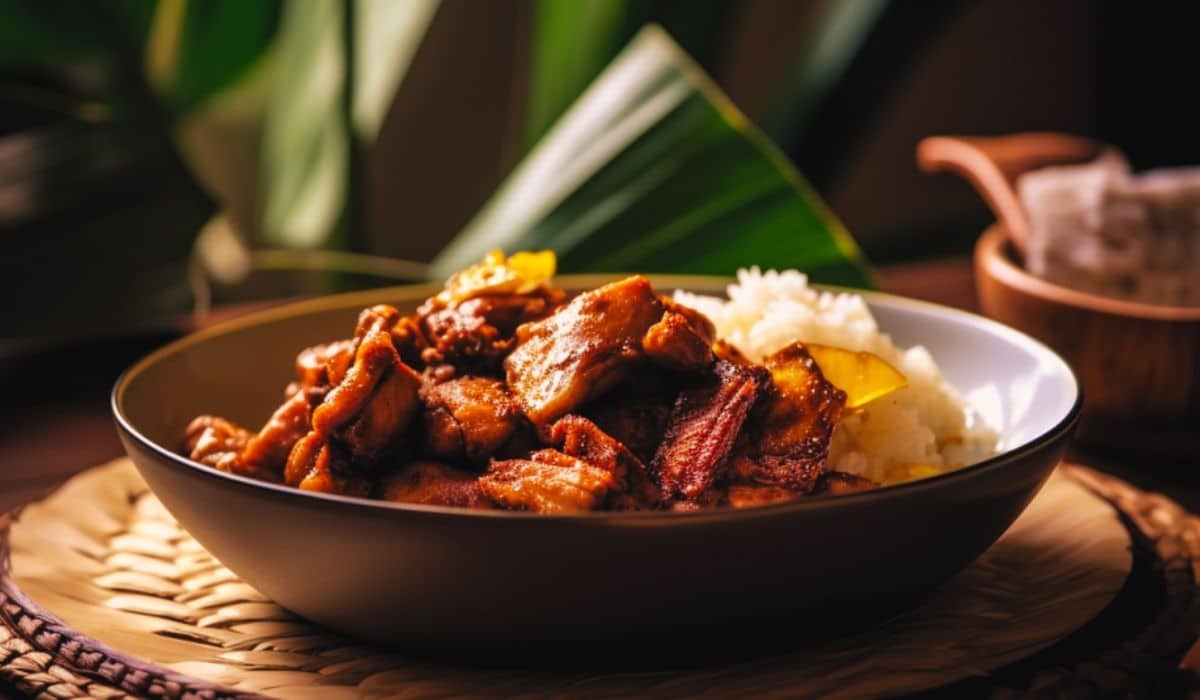The Tangy & Tender Filipino Adobo Recipe Everyone Loves
Succulent meats marinating in a classic filipino adobo create a symphony of tangy, savory flavors that dance across your palate.
Vinegar and soy sauce form the soul of this beloved dish, whisking you into a culinary journey through philippine kitchens.
Regional variations add unique twists to the traditional recipe, making each bite a personal narrative.
Bold spices intermingle with tender protein, promising a meal that speaks directly to comfort and tradition.
Generations have perfected this recipe, passing down secrets that transform simple ingredients into something magical.
Your taste buds will thank you for exploring this rich, deeply satisfying culinary treasure that captures the heart of philippine cuisine.
Dig in and let the flavors transport you to sun-drenched islands and bustling markets.
Why Filipino Adobo Is Rich, Bold, And Craveable
What You’ll Need For Authentic Filipino Adobo
Protein:Aromatics:Seasoning and Liquid Base:Optional Additions:Cooking Essentials:How To Make Filipino Adobo The Easy Way
Step 1: Prep the Protein
Pat the protein pieces dry using paper towels. This helps achieve better browning and creates a delicious caramelized exterior.
Step 2: Heat the Cooking Surface
Warm cooking oil in a heavy-bottomed pot over medium-high heat until the oil starts to shimmer and release a fragrant aroma.
Step 3: Create Golden Crusts
Sear the protein in batches, developing a rich golden-brown crust on all sides. Cook each side for about 3-4 minutes to lock in flavors.
Step 4: Build Flavor Base
Remove browned protein and set aside. In the same pot, quickly sauté:Cook until the ingredients become translucent and release their aromatic qualities.
Step 5: Combine Ingredients
Return protein to the pot and add:Step 6: Bring to Boil and Simmer
Bring the mixture to a vigorous boil, then immediately reduce heat to low and cover the pot. Simmer gently to tenderize the protein.
Step 7: Slow Cook
Simmer the protein for 30-40 minutes. Stir occasionally to prevent sticking and ensure even cooking.
Step 8: Add Liver (Optional)
If using chicken liver, add it during the final 10 minutes of cooking to prevent overcooking.
Step 9: Finish and Reduce
Cook until the protein becomes tender and the sauce reduces by approximately one-third. Remove bay leaves.
Step 10: Enhance Spiciness (Optional)
Add sliced red chili pepper during the final minutes for extra heat and excitement.
Step 11: Plate and Garnish
Transfer the adobo to a serving platter. Sprinkle chopped green onions on top for a fresh, vibrant touch.
Step 12: Rest and Serve
Allow the adobo to rest for 5 minutes. This helps the flavors meld together and allows the sauce to slightly thicken, creating a more intense taste experience.
Pro Tips For Big Flavor In Filipino Adobo
Tasty Twists On Classic Filipino Adobo
What Complements Filipino Adobo Best
How To Store Filipino Adobo Without Losing Flavor
Filipino Adobo Questions Answered Simply
Patting the protein dry helps remove excess moisture, allowing for better browning and caramelization, which creates a more flavorful and visually appealing dish.
Yes, Filipino adobo is versatile and works well with chicken, pork, beef, or even seafood. Each protein brings its own unique texture and flavor to the dish.
The combination of soy sauce and white vinegar creates the signature tangy and savory taste that makes adobo so beloved in Filipino cuisine. The balance of these two ingredients is key to the dish’s unique flavor profile.
Print
Filipino Adobo Recipe
- Total Time: 60-70 minutes
- Yield: 4 1x
Description
Culinary magic happens when Filipino Adobo simmers with tangy vinegar and rich soy sauce, creating a legendary dish that dances between savory and sharp. Comfort meets tradition in this classic Filipino masterpiece that will transport diners straight to Manila’s bustling kitchens.
Ingredients
Protein:
- 2 lbs chicken thighs or pork belly
- 0.5 lbs chicken liver (optional)
Liquid and Seasoning:
- 0.5 cup white vinegar
- 0.5 cup soy sauce
- 1 cup water
- 4 cloves garlic
- 2 bay leaves
- 1 tsp whole black peppercorns
Garnish and Additional Ingredients:
- 2 tbsp cooking oil
- 1 small onion
- 1 green onion (for garnish)
- 1 red chili pepper (optional)
Instructions
- Pat the protein pieces dry with paper towels to ensure optimal browning and caramelization.
- Heat cooking oil in a heavy-bottomed pot over medium-high heat until shimmering and fragrant.
- Sear the protein in batches, developing a rich golden-brown crust on all sides, approximately 3-4 minutes per side.
- Remove browned protein and set aside, then quickly sauté minced garlic and diced onions in the same pot until translucent and aromatic.
- Return protein to the pot and add soy sauce, white vinegar, water, bay leaves, and whole black peppercorns.
- Bring the mixture to a vigorous boil, then immediately reduce heat to low and cover the pot.
- Simmer the protein for 30-40 minutes, occasionally stirring to prevent sticking and ensure even cooking.
- If using chicken liver, add it during the last 10 minutes of cooking to prevent overcooking.
- Once protein is tender and sauce has reduced by one-third, remove bay leaves.
- Optional: Add sliced red chili pepper for extra heat during the final minutes of cooking.
- Transfer to a serving platter and garnish with chopped green onions.
- Let the adobo rest for 5 minutes before serving to allow flavors to meld and sauce to slightly thicken.
Notes
- Ensure meats are thoroughly dried before searing to achieve a perfect golden-brown exterior with maximum flavor development.
- Avoid overcrowding the pot when browning protein, which prevents proper caramelization and creates steaming instead of searing.
- Experiment with protein variations like pork belly, chicken thighs, or tofu for different texture and flavor profiles while maintaining the classic adobo technique.
- For a lighter version, skim excess fat from the surface during cooking and use leaner meat cuts to reduce overall calorie content.
- Prep Time: 10 minutes
- Cook Time: 50-60 minutes
- Category: Dinner, Lunch, Appetizer
- Method: Simmering
- Cuisine: Filipino
Nutrition
- Serving Size: 4
- Calories: 450
- Sugar: 2 g
- Sodium: 950 mg
- Fat: 25 g
- Saturated Fat: 6 g
- Unsaturated Fat: 15 g
- Trans Fat: 0 g
- Carbohydrates: 10 g
- Fiber: 1 g
- Protein: 36 g
- Cholesterol: 150 mg




Truc Tran (Kris)
Senior Food Editor
Expertise
Home Cooking, Meal Planning, Recipe Development, Baking and Pastry, Food Editor, Cooking-video Maker, Vietnamese Food Evaluation Expert
Education
Truc Tran (Kris), an experienced food writer and editor, is great at exploring and describing global cuisines, from simple street food to fancy dining. In her writing, she skillfully mixes different flavors, cooking methods, and culinary traditions, showing the unique character of various cultures through their food and drinks. On azcuisines.com, Kris highlights her knowledge, especially in Asian cuisine and worldwide traditional dishes.